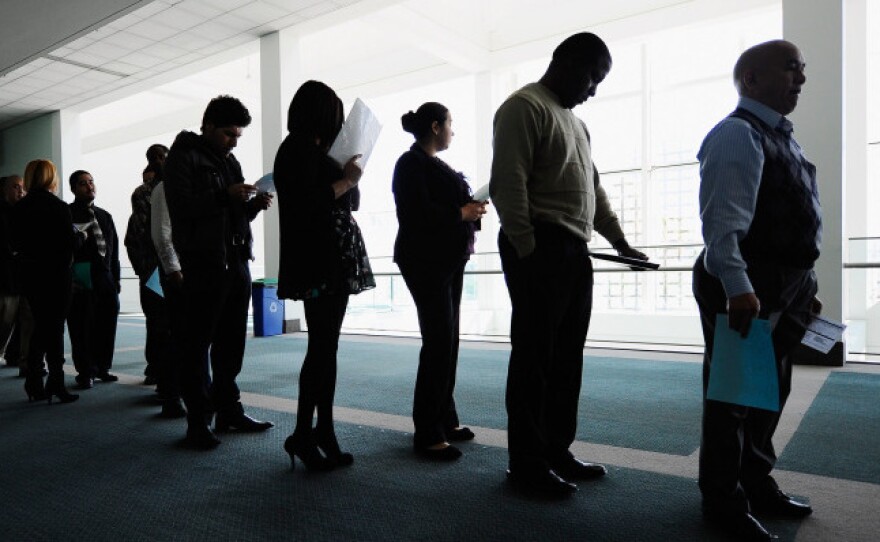Diane Turner can't find work. She spent 30 years managing dental practices in Sonoma County, north of San Francisco, but lost her last job in that field a couple of years ago.
She worked for a while greeting customers at an auto body shop, but lost that job a year ago. "It was very depressing," Turner says. "I always worked, and I was always able to get a job."
Having seen firsthand how competition for jobs is "absolutely fierce" — more than 200 applicants sometimes turn up even when part-time jobs are listed — Turner is not surprised to learn that the unemployment rate is slow to come down.
On Friday, the Bureau of Labor Statistics reported the economy gained a net total of 120,000 jobs in March, and that the unemployment rate declined to 8.2 percent.
Unemployment peaked in October 2009 at 10 percent. While the decline since has been slow, the fact that the numbers are trending down means that people who have been unemployed for an extended period, such as Turner, are going to have a harder time collecting benefits.
Under a law enacted last month, Congress is ratcheting down the length of time that the unemployed can receive cash assistance.
As a result, more than 135,000 workers in 15 states stand to see their unemployment checks run out in April alone, according to the National Employment Law Project, an advocacy group.
"Come December, it's a very steep cliff," says George Wentworth, a senior staff attorney with NELP. "If you become unemployed after July 1, you're probably not going to see any federal benefits."
A Convoluted System
The system of determining who is eligible for unemployment benefits and who pays the cost is surprisingly complex.
For the most part, states are responsible for the first few months. Most states pay for the first 26 weeks of benefits, although there are exceptions.
After that, the feds take over. There are formulas that are supposed to kick in when the unemployment rate reaches a certain level, but those almost never work in reality, says Gary Burtless, a senior fellow in economic studies at the Brookings Institution.
Instead, with each modern recession, Congress has stepped in and paid for benefits that stretch out as long as 99 weeks. That's the pool of money that Congress — now that unemployment is starting to come down — is starting to empty out.
"Even though the unemployment rate is still high, because it's no longer on an upward trajectory, the program starts to shut down," Wentworth says.
Running Out Of Money
The states certainly aren't going to step in and make up the difference. In fact, in most cases, the state trust funds that pay for the first six months or so of unemployment coverage are not just depleted but deep in the red.
As part of the stimulus package passed in 2009, the federal government decided to allow states to borrow money, without interest, to pay their share of unemployment benefits.
And borrow they did. All told, some three-dozen states owe the Treasury nearly $40 billion.
Those bills have come due. In order to pay back the Treasury, states are raising the taxes they collect from employers to fund unemployment coverage — or, more often, cutting back on the levels of benefits they offer.
"What's happening is you've got these large-scale changes at the federal level, which in turn has triggered changes at the state level," says Sujit CanagaRetna, a fiscal analyst with the Council of State Governments, "which means a lot of folks are going to lose their benefits a lot faster than they have before."
Long-Term Problems
The system might be complicated, but there's a reason to put time limits on benefits, says Greg Acs, an economist at the Urban Institute.
"It's not permanent support, so you have an incentive not to find work," Acs says. "If you lose a job, it's a good idea to spend a little time searching to find a good match, but you don't want people to be too selective."
Congress can always step in and provide more weeks of benefits when the job market is especially challenging. But as the federal extended benefits program gets dialed back, where does that leave people who remain out of work?
Long-term unemployment has been a signal feature of the recent downturn. The new jobs report shows that the average unemployed person has been out of work for nearly 40 weeks — longer than any state will provide coverage. More than 5 million people — or 42.5 percent of the total — have been out of work for six months or longer.
That's much longer than historic norms. The previous peak came during the recession of the early 1980s, when 26 percent of the unemployed were out of work for more than six months.
Not Many Options
A recent study by the Government Accountability Office found that 2 million people had exhausted their unemployment insurance coverage as early as 2009. Few of them — less than 3 percent — qualified for welfare, generally because they didn't have children younger than 18.
Because of their broader budget problems, most states have cut funding for other cash assistance programs. That means people like Diane Turner, once they have exhausted their unemployment benefits, are pretty well out of luck.
"It affects you on every level," says Turner, who is 52. "You eat less. You don't go out and socialize. You have to work within your parameters."
Copyright 2022 NPR. To see more, visit https://www.npr.org. 9(MDAzMjM2NDYzMDEyMzc1Njk5NjAxNzY3OQ001))






